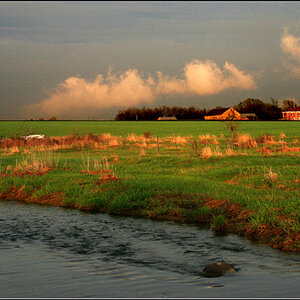I've been lense shopping (more specifically Nikon and Canon) and I'm quite overwhelmed by the selection. I can't quite figure out the differences between lenses that are similar in specs but 500 dollars apart in price range. Obviously I want to buy the best glass possible, but how much difference can you see between lenses and is it proportional to the price jumps. How do I really rank lenses? besides price.... thanks.
Navigation
Install the app
How to install the app on iOS
Follow along with the video below to see how to install our site as a web app on your home screen.

Note: This feature currently requires accessing the site using the built-in Safari browser.
More options
You are using an out of date browser. It may not display this or other websites correctly.
You should upgrade or use an alternative browser.
You should upgrade or use an alternative browser.
Lense qualities
- Thread starter Youngun
- Start date
- Joined
- May 15, 2003
- Messages
- 5,275
- Reaction score
- 17
- Location
- Gilbert, AZ
- Website
- www.voodoocat.com
- Can others edit my Photos
- Photos NOT OK to edit
You get what you pay for when it comes to lenses. The contrast (in lenses it's the ability to seperate and render detail) on the better lenses make it worth your while to save up.
ksmattfish
Now 100% DC - not as cool as I once was, but still
- Joined
- Aug 25, 2003
- Messages
- 7,019
- Reaction score
- 36
- Location
- Lawrence, KS
- Website
- www.henrypeach.com
- Can others edit my Photos
- Photos NOT OK to edit
Almost any lens built in the last 60 to 75 years will do a great job in the center of the image circle at medium apertures.
Lenses with a greater image circle (usually means more glass and size), and/or wider maximum apertures are much trickier to produce, so the price reflects this.
Would you see an image quality difference between a $150 lens and a $1000 lens at f/8? Probably not. But at f/2? Probably more likely that you'd notice a difference. Even so, it may only be at the edges and corners of the image.
When comparing prices look at max aperture. You'll find this measure goes right along with price. A 28-105 zoom that maxes out at f/4 (at 28mm, at 105mm it jumps up to f/5.6) is $200. The 28-105 that opens up to f/2 (stays at f/2 through out the focal length range) costs $1000+.
And of course when they are building in additional costly feature such as image stabilization, etc... that'll add to the price.
I'm currently doing about 75% of my photography with an Ansco Titan which has a 75mm f/4 anastigmat lens (which is a simple 3 element lens design that is at least 80 years old). This particular camera/lens was probably built in the 1950's. At apertures of f/8 through f/16, and print sizes of 11x14 and less, it's as sharp as anything I've got that is "state of the art". You would only notice a slight softening at the very edges of the largest prints.
I have a Zeiss Ikonta camera with a 105mm f/4.5 tessar lens (more advanced design than the anastigmat) that was built 20 (approx 1937) years before the Titan, and is even slightly sharper.
Lenses with a greater image circle (usually means more glass and size), and/or wider maximum apertures are much trickier to produce, so the price reflects this.
Would you see an image quality difference between a $150 lens and a $1000 lens at f/8? Probably not. But at f/2? Probably more likely that you'd notice a difference. Even so, it may only be at the edges and corners of the image.
When comparing prices look at max aperture. You'll find this measure goes right along with price. A 28-105 zoom that maxes out at f/4 (at 28mm, at 105mm it jumps up to f/5.6) is $200. The 28-105 that opens up to f/2 (stays at f/2 through out the focal length range) costs $1000+.
And of course when they are building in additional costly feature such as image stabilization, etc... that'll add to the price.
I'm currently doing about 75% of my photography with an Ansco Titan which has a 75mm f/4 anastigmat lens (which is a simple 3 element lens design that is at least 80 years old). This particular camera/lens was probably built in the 1950's. At apertures of f/8 through f/16, and print sizes of 11x14 and less, it's as sharp as anything I've got that is "state of the art". You would only notice a slight softening at the very edges of the largest prints.
I have a Zeiss Ikonta camera with a 105mm f/4.5 tessar lens (more advanced design than the anastigmat) that was built 20 (approx 1937) years before the Titan, and is even slightly sharper.
- Joined
- Dec 16, 2003
- Messages
- 33,896
- Reaction score
- 1,853
- Location
- Edmonton
- Website
- www.mikehodson.ca
- Can others edit my Photos
- Photos NOT OK to edit
Pro level lenses (like Canon 'L' series) are also built to take the rigors of pro photography. They are better sealed to keep out contaminants and keep the optics and mechanics clean and working properly.
There are lots of lists on the Internet that will rate all the lenses from both Canon & Nikon. There are some gems and some stinkers.
Like Matt said, most lenses are pretty good at middle apertures in the center of the frame. On 4X6 or 5X7 prints it would be hard to notice a difference between a $300 lens and a $1300 lens. (to anyone who doesn't spend their time hanging out on photography internet sites )
)
There are lots of lists on the Internet that will rate all the lenses from both Canon & Nikon. There are some gems and some stinkers.
Like Matt said, most lenses are pretty good at middle apertures in the center of the frame. On 4X6 or 5X7 prints it would be hard to notice a difference between a $300 lens and a $1300 lens. (to anyone who doesn't spend their time hanging out on photography internet sites
- Joined
- Dec 16, 2003
- Messages
- 33,896
- Reaction score
- 1,853
- Location
- Edmonton
- Website
- www.mikehodson.ca
- Can others edit my Photos
- Photos NOT OK to edit
Non-zoom lenses are usually better quality for the money because they are less complicated. There are top quality zoom lenses but they are very expensive.
ksmattfish
Now 100% DC - not as cool as I once was, but still
- Joined
- Aug 25, 2003
- Messages
- 7,019
- Reaction score
- 36
- Location
- Lawrence, KS
- Website
- www.henrypeach.com
- Can others edit my Photos
- Photos NOT OK to edit
The quality difference has been getting smaller and smaller. Pre 1995 prime lenses were probably slightly better than zooms. Today I doubt most folks could spot the difference until you get up to some really big prints.
The big difference is that fast (f/2 or better) primes are affordable, and fast zooms are not ($1000+). Affordable zooms tend to max out around f/4 (and that's at the widest focal length, at the longer focal lengths this can jump up a stop or two).
The big difference is that fast (f/2 or better) primes are affordable, and fast zooms are not ($1000+). Affordable zooms tend to max out around f/4 (and that's at the widest focal length, at the longer focal lengths this can jump up a stop or two).
TomRussell
TPF Noob!
- Joined
- Jul 14, 2004
- Messages
- 19
- Reaction score
- 0
Primes are generally considered to be sharper if used properly than zooms - plus they are ALOT cheaper to buy.
The only advice i'd give you is before laying out money on a lens take your camera body into a photo shop and ask if you can try one out..step just out of the door for a second and shoot the street, get the feel for it, run through all the aperture combos... wide open wide-angle, wide open full zoom, f/22 if its' bright enough or another quite half shut aperture...take the photos home and check the sharpness on ALL of the photos against similar ranges from your current lenses.
Try before you buy.
The only advice i'd give you is before laying out money on a lens take your camera body into a photo shop and ask if you can try one out..step just out of the door for a second and shoot the street, get the feel for it, run through all the aperture combos... wide open wide-angle, wide open full zoom, f/22 if its' bright enough or another quite half shut aperture...take the photos home and check the sharpness on ALL of the photos against similar ranges from your current lenses.
Try before you buy.
ksmattfish
Now 100% DC - not as cool as I once was, but still
- Joined
- Aug 25, 2003
- Messages
- 7,019
- Reaction score
- 36
- Location
- Lawrence, KS
- Website
- www.henrypeach.com
- Can others edit my Photos
- Photos NOT OK to edit
TomRussell said:Try before you buy.
Excellent advice. My experience is that there can be quite a big difference between supposedly identical model lenses. I've seen gems, and I've seen lemons; hold onto the gems.
Slowboat
TPF Noob!
To evaluate lens quality I usually take a look at http://www.photodo.com and use that as a base to start and not as gospel. When I find a lens that will suite my needs I rent it for a few days to get an overall feel for the lens and its ability, after that I go to my favorite pro shot and ask to try the same lens out. As mentioned by others, the same model lens can be dead on sharp or lousy.
If looking at zoom lenses, try to look at the ones that have a relatively short zoom range instead of a zoom that goes from the wide end to telephoto, the quality usually tends to be much better.
If looking at zoom lenses, try to look at the ones that have a relatively short zoom range instead of a zoom that goes from the wide end to telephoto, the quality usually tends to be much better.
Slowboat
TPF Noob!
Oh, and here is a good read for a laugh or two. 
The Seven Levels of Photography - http://www.kenrockwell.com/tech/7.htm
The Seven Levels of Photography - http://www.kenrockwell.com/tech/7.htm
Most reactions
-
 426
426 -
 294
294 -
 285
285 -
 270
270 -
 221
221 -
 204
204 -
 185
185 -
 180
180 -
 168
168 -
 167
167 -
 146
146 -
 133
133 -
 120
120 -
 95
95 -
I
94
Similar threads
- Locked
- Replies
- 26
- Views
- 4K
- Replies
- 0
- Views
- 843
- Replies
- 12
- Views
- 1K
- Replies
- 0
- Views
- 1K




![[No title]](/data/xfmg/thumbnail/32/32631-60d0db057ee085953a0921e337396654.jpg?1619735552)
![[No title]](/data/xfmg/thumbnail/32/32719-7d42e7d7077540fabb3fa0275a99899a.jpg?1619735625)


![[No title]](/data/xfmg/thumbnail/32/32718-19d5f7764b6f43f6cec5a67701261560.jpg?1619735624)
![[No title]](/data/xfmg/thumbnail/37/37617-2a07b7e10a8d9f154e8cd9727551e0ef.jpg?1619738151)
![[No title]](/data/xfmg/thumbnail/34/34345-5642c495cae8d6c7bb83c28664146cf1.jpg?1619736381)

